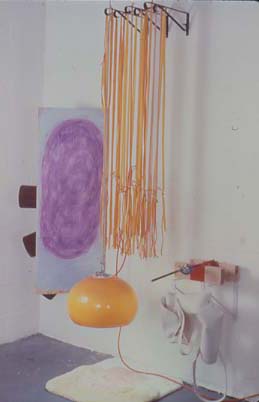
|
|
Making Art:
Assignments for Teachers
Diorama
Collaborative Collage
Sculpture vs. Painting
Diorama: Creating
an Environment with Everyday Objects
Materials: Found objects, cardboard boxes, construction paper, magic markers
or paint, scissors, pencils and paper.
Activity:
Part 1: Show students Stockholder’s works. Ask them to describe what they
see, and to create a list of verbs, adverbs, and adjectives to describe the
actions depicted in Stockholder’s works.
Part 2: Ask students to bring in small, ordinary objects to class. Split
students into groups of four or five. Give each group a large cardboard box,
and ask them to decorate it with construction paper, color it with markers
or paint, and incorporate their ordinary objects into the design. Ordinary
objects should also be drawn upon, torn, cut or altered.
Discussion: Ask each student to write a short story about their built
environment. As them to consider what happens in the space, who inhabits the
space, what it is used for, and what will happen next. Ask them to describe
what actions occur in their space, using the same types of verbs, adverbs,
and adjectives used in their description of Stockholder’s works.
Collaborative Collage: Colors & Shapes
Materials: Construction paper, multi-colored yarn, one big piece of white
paper, scissors.
Preparation: Explain to students what primary, secondary, and complementary
colors are (see glossary). Show them Jessica Stockholders.
Activity: Divide students into groups of 4-5. Select several shapes such as
rectangles, circles, triangles, organic shapes, or numbers or letters. Ask
students to make cutout of shapes, using various colors of construction
paper. Some shapes will be very large, others will be small, and others will
be medium-sized. Put a very large sheet of white paper on the floor. Ask
students to take turns, placing shapes on the floor one by one. Also have
students use yarn, to represent lines. Students must use all materials. Once
they are finished, ask students to glue the paper in place.
Discussion: Have students look at all of the collages, and to describe them.
Ask students to compare and contrast they way the same shapes and colors are
used in different settings. Ask students to describe the colors used, their
relationships to each other, and the relations between the shapes and lines.
Ask them to determine where objects are in space in relation to each other.
What is
Sculpture? What is Painting?
Reference: Paige Hebert
Materials: Pencils, paper.
Activity: Split the class into small groups of four or five students. As
each group to collectively define what sculpture is, and then what a
painting is. They can either make a definition or they can list criteria for
each type of artwork.
For instance, students may
ask:
- In order to be a sculpture, what
components must and artwork include?
- In order to be a painting, what elements
must an artwork include?
Discussion: Ask students to read their
definitions of sculpture and painting. Show the class Stockholder’s artwork.
Discuss the media and whether it can be characterized as sculpture or
painting.
|


